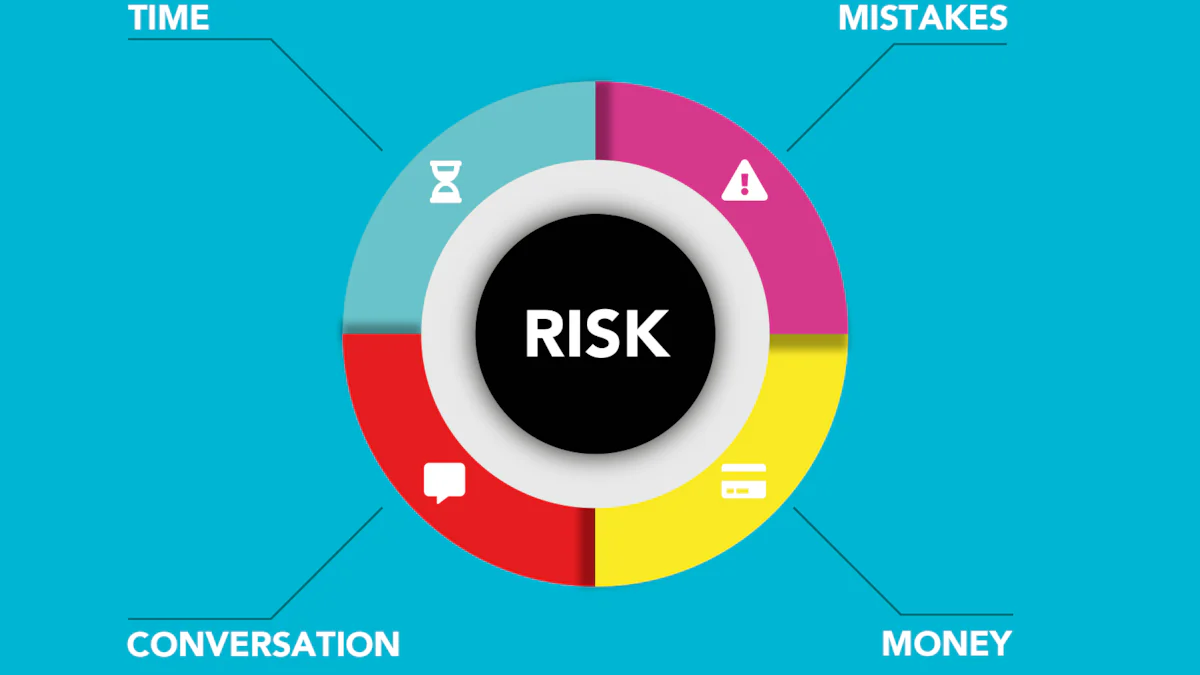How to Identify and Mitigate Supply Chain Risks for 2024-2025

Managing supply chain risk has become crucial in today's volatile business environment. A survey by Deloitte Touche Tohmatsu revealed that 85% of global supply chains faced disruptions in the past year. The COVID-19 pandemic further exacerbated these challenges, with 73% of companies experiencing significant supply-side disruptions. As businesses look ahead to 2024-2025, focusing on mitigating these risks becomes even more relevant. Companies that proactively manage supply chain risks can reduce disruption costs by 50%, highlighting the importance of strategic planning and resilience in navigating future uncertainties.
Understanding Supply Chain Risks

In today's interconnected world, supply chain risk poses significant challenges to businesses. Understanding these risks is crucial for developing effective mitigation strategies.
Types of Supply Chain Risks
Operational Risks
Operational risks arise from disruptions in daily activities. These include equipment failures, labor strikes, and logistical challenges. Companies must ensure smooth operations to avoid costly delays and inefficiencies.
Financial Risks
Financial risks involve fluctuations in currency exchange rates, credit issues, and economic downturns. Businesses need to manage these risks to maintain financial stability and protect profit margins.
Strategic Risks
Strategic risks occur when a company's long-term plans face threats. These can stem from market changes, competitive pressures, or shifts in consumer preferences. Adapting strategies to align with market dynamics is essential.
Compliance Risks
Compliance risks relate to adhering to laws and regulations. Non-compliance can lead to fines and reputational damage. Companies must stay informed about regulatory changes to mitigate these risks.
Emerging Risks for 2024-2025
Technological Disruptions
Technological advancements bring both opportunities and risks. Automation and AI can enhance efficiency but also introduce vulnerabilities. Companies should invest in cybersecurity to protect against potential threats.
Geopolitical Instabilities
Geopolitical tensions can disrupt supply chains through trade restrictions and tariffs. Businesses must diversify suppliers and establish nearshore sources to mitigate these risks.
Environmental Concerns
Environmental risks, such as climate change and natural disasters, pose significant threats. Companies should develop sustainable practices and contingency plans to address these challenges.
"Supply chains are perennially at risk of disruption, whether via a global event like the pandemic or local conditions such as hurricanes, blizzards, heat waves, or labor strikes."
By understanding and addressing these supply chain risks, businesses can enhance resilience and ensure continuity in an unpredictable world.
Identifying Risks in Your Supply Chain
Understanding and identifying supply chain risk management is essential for maintaining business continuity. Companies must adopt systematic approaches to uncover vulnerabilities and prepare for potential disruptions.
Conducting a Risk Assessment
Mapping the Supply Chain
Mapping the supply chain involves creating a detailed visualization of every component, from suppliers to end customers. This process helps businesses understand the flow of goods and identify critical nodes. By examining each link, companies can pinpoint areas susceptible to disruptions. For instance, Apple's Extensive Supply Chain Risk Management highlights the importance of mapping to foresee potential risks and develop effective contingency plans.
Identifying Vulnerabilities
Once the supply chain is mapped, identifying vulnerabilities becomes the next step. Companies should assess each node for weaknesses, such as reliance on single suppliers or exposure to geopolitical tensions. A thorough evaluation allows businesses to prioritize areas needing immediate attention. The case of FMCG Major Transforms Supply Chain Risk Management demonstrates how identifying vulnerabilities can lead to building more resilient and agile supply chains.
Tools and Techniques
SWOT Analysis
SWOT Analysis serves as a powerful tool for evaluating supply chain risk. By examining strengths, weaknesses, opportunities, and threats, companies gain insights into internal and external factors affecting their operations. This analysis helps in crafting strategies that leverage strengths and mitigate weaknesses.
Risk Matrices
Risk matrices provide a structured approach to assess the likelihood and impact of various risks. By plotting risks on a matrix, businesses can prioritize them based on severity and probability. This method enables organizations to focus resources on the most critical threats, ensuring a proactive stance in risk management.
"Supply chains are perennially at risk of disruption, whether via a global event like the pandemic or local conditions such as hurricanes, blizzards, heat waves, or labor strikes."
By employing these strategies and tools, companies can effectively identify and manage supply chain risk, enhancing their ability to navigate uncertainties and maintain operational stability.
Planning for Risk Mitigation
Effective planning for risk mitigation is essential for maintaining a resilient supply chain. Companies must develop strategies that prioritize risks and involve key stakeholders to ensure comprehensive management.
Developing a Risk Management Strategy
Setting Priorities
Setting priorities in risk management involves identifying the most critical supply chain risks that could impact operations. Companies should evaluate risks based on their potential impact and likelihood of occurrence. By focusing on high-priority risks, businesses can allocate resources efficiently and implement targeted mitigation measures. This approach ensures that the most significant threats receive immediate attention, reducing the potential for disruptions.
Involving Stakeholders
Involving stakeholders in the risk management process is crucial for developing a well-rounded strategy. Stakeholders include top management, employees, suppliers, and sometimes even customers. Their diverse perspectives and expertise contribute to a holistic understanding of supply chain risks. Engaging stakeholders fosters collaboration and ensures that all parties are aligned in their efforts to mitigate risks. As one expert notes, "The active involvement of stakeholders is indispensable for crafting a comprehensive and effective risk management plan."
Creating Contingency Plans
Scenario Planning
Scenario planning involves anticipating various potential disruptions and developing strategies to address them. Companies should create detailed scenarios that outline possible supply chain risks and their implications. By preparing for different outcomes, businesses can respond swiftly and effectively when faced with unexpected challenges. Scenario planning enhances a company's ability to adapt to changing circumstances and maintain operational continuity.
Crisis Management
Crisis management focuses on responding to supply chain disruptions in real-time. Companies must establish clear protocols for managing crises, including communication plans and decision-making processes. A well-defined crisis management plan enables businesses to act decisively and minimize the impact of disruptions. Training employees in crisis response ensures that everyone understands their roles and responsibilities, contributing to a coordinated and efficient response.
"Create risk awareness in your company. Information is power, and having employees with the right knowledge about supply-chain risks puts your company in a better position to deal with known and unknown risks."
By implementing these strategies, companies can effectively mitigate supply chain risk and enhance their resilience in an unpredictable environment.
Implementing Risk Mitigation Strategies

Implementing effective strategies is crucial for mitigating supply chain risk. Companies must leverage technology and build resilient supply chains to navigate uncertainties.
Leveraging Technology
JUSDA Solutions
JUSDA offers innovative solutions by utilizing IoT and big data for logistics management. They collect and analyze vast amounts of data, providing businesses with real-time insights and predictive analytics. This approach enhances logistics accuracy and efficiency, allowing companies to make informed decisions and reduce supply chain risk.
Real-time Monitoring Systems
Real-time monitoring systems play a vital role in managing supply chain risk. These systems provide continuous visibility into operations, enabling businesses to detect disruptions early. By implementing real-time monitoring, companies can respond swiftly to potential issues, ensuring smooth operations and minimizing delays.
Building Resilient Supply Chains
Diversifying Suppliers
Diversifying suppliers reduces dependency on a single source, which is essential for mitigating supply chain risk. Companies should establish relationships with multiple suppliers to ensure continuity in case of disruptions. This strategy enhances flexibility and reduces vulnerability to geopolitical tensions or natural disasters.
Strengthening Partnerships
Strengthening partnerships with suppliers and stakeholders fosters collaboration and trust. Companies should work closely with partners to align goals and share information. Strong partnerships enhance resilience by creating a supportive network that can adapt to changes and manage supply chain risk effectively.
"Supply chains are perennially at risk of disruption, whether via a global event like the pandemic or local conditions such as hurricanes, blizzards, heat waves, or labor strikes."
By leveraging technology and building resilient supply chains, businesses can effectively mitigate supply chain risk and ensure operational stability in an unpredictable environment.
Monitoring and Reviewing Risk Management Efforts
Effective supply chain risk management requires continuous monitoring and regular reviews. Companies must remain vigilant to adapt to the ever-changing landscape of supply chain challenges.
Continuous Monitoring
Continuous monitoring plays a crucial role in identifying potential disruptions early. Businesses must implement systems that provide real-time insights into their operations.
Key Performance Indicators
Key Performance Indicators (KPIs) serve as essential tools for tracking supply chain performance. Companies should establish KPIs that align with their risk management objectives. These indicators help in measuring efficiency, identifying bottlenecks, and assessing the effectiveness of risk mitigation strategies. For instance, monitoring delivery times and inventory levels can reveal potential supply chain risks before they escalate.
Regular Audits
Regular audits ensure that risk management processes remain effective and compliant with industry standards. Companies should conduct audits to evaluate their supply chain's resilience and identify areas for improvement. Audits provide an opportunity to assess the implementation of risk mitigation strategies and verify that all stakeholders adhere to established protocols. By conducting regular audits, businesses can maintain a proactive approach to managing supply chain risk.
"A recent survey revealed that 63% of respondents reported their risk readiness remained unchanged from 2021, highlighting the need for continuous improvement in risk management practices."
Reviewing and Updating Strategies
Reviewing and updating risk management strategies is vital for adapting to new challenges and opportunities. Companies must remain flexible and responsive to changes in the supply chain environment.
Feedback Loops
Feedback loops facilitate the continuous improvement of risk management strategies. Companies should establish mechanisms for collecting feedback from stakeholders, including suppliers, employees, and customers. This feedback provides valuable insights into the effectiveness of current strategies and highlights areas for enhancement. By incorporating feedback into their risk management processes, businesses can refine their approaches and better address supply chain risk.
Adapting to Changes
Adapting to changes in the supply chain landscape is essential for maintaining resilience. Companies must stay informed about emerging trends and potential threats. This requires a commitment to ongoing education and investment in risk management technologies. According to a survey, 52% of supply chain decision-makers reported that their companies are investing in risk management services or technologies. By staying ahead of the curve, businesses can effectively mitigate supply chain risk and ensure operational continuity.
"71% of company executives acknowledged that their companies face greater risks from supply-chain disruption than before, underscoring the importance of adaptive strategies."
By implementing continuous monitoring and regularly reviewing risk management efforts, companies can enhance their ability to navigate supply chain risk. This proactive approach ensures that businesses remain resilient and prepared for future uncertainties.
Managing supply chain risks requires a strategic approach. Key strategies include identifying vulnerabilities, leveraging technology, and diversifying suppliers. Proactive risk management is essential. It reduces disruptions and enhances resilience, providing a competitive edge. Companies must prioritize risks to ensure critical threats receive immediate attention. Staying informed and adaptable is crucial. Continuous improvement in risk management practices safeguards operations and boosts profitability. By embracing these strategies, businesses can navigate uncertainties effectively and maintain operational continuity.
See Also
Don't Overlook Risks in Your Supply Chain: Ensure Protection
Sustainability in Addressing Supply Chain Risks
Managing Risks: Securing Your Supply Chain
Stay Ready: JUSDA Ensures Resilient Supply Chain Risk Management
Navigating Smoothly: Effective Guidance for Supply Chain Risk Management
